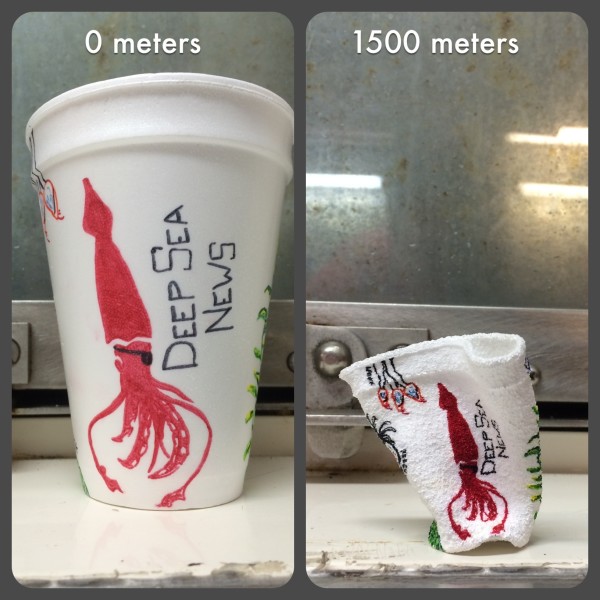 A comment on Reddit reminded me of a question that I have received many times. The question is always a good one because it stems from knowledge and deductive reasoning. The said question requires one to know that one of the most extreme environmental gradients is the increase of pressure with increasing depth, at the surface being 1 atmospheres and reaching well over 1,000 atmospheres in deepest parts of the ocean. The question? How do organisms survive this great pressure and what happens to organisms when you bring them to the surface?
A comment on Reddit reminded me of a question that I have received many times. The question is always a good one because it stems from knowledge and deductive reasoning. The said question requires one to know that one of the most extreme environmental gradients is the increase of pressure with increasing depth, at the surface being 1 atmospheres and reaching well over 1,000 atmospheres in deepest parts of the ocean. The question? How do organisms survive this great pressure and what happens to organisms when you bring them to the surface?
I really never get tired of answering this question. The short: pressure, or the lack of when you bring them back up to the surface doesn’t typically kill deep-sea organisms warmer temperature does. Several studies indicate the deep-sea organisms can withstand a wide range of pressures. We frequently capture organisms at depth and bring them to surface alive, as long as we can keep them cool. They either live in aquarium in the laboratory or even shipped across the country alive. I’ve personally kept or seen deep-sea snails, echinoderms, crabs, giant isopods, and cephalopods in aquaria. Some pelagic organisms also have amazing vertical migrations during the course of 24 hours that can encompass 1000’s of meters and many levels of pressure. Basically, putting a low-pressure adapted animal into high pressures will often kill it but deep-sea animals often seem immune to the release of pressure.* Understanding how deep-sea animals are adapted to pressure will help you understand why this is.
Now some more specifics.
- Cell membranes: As you may remember from high school or college biology, a cellular membrane consists of lipid bilayer. The structure is entirely maintained by the interaction of charges (or lack of) between water and the phospholipids. This makes the membrane semipermeable much like a layer of oil on water. Extreme pressure results in a tighter packing of the phospholipids which lowers the permeability of the membrane. One adaptation by deep-sea animals is to increase cellular permeability is to increase the percentage of unsaturated fatty acids. In a saturated fatty acid all the carbons in the chain are lined by a single covalent bond. As you recall, a carbon can take four chemical bonds. If all these bonds are covalent (single) then a carbon could potentially attach to 4 other atoms. Thus the saturated comes from the fact that the carbon chain is loaded with hydrogens. If a carbon forms a double bond with another atom then the carbon would have to bond with one less hydrogen. Thus an unsaturated fatty acid is one with double bonds and not ‘saturated’ with hydrogens. The double covalent bond between adjacent carbons in an unsaturated fatty acid leads to a ‘kink’ in the tails of the molecule. Thus increasing their concentration in membrane leads to a looser packing.
- Enzyme shape: At the basic level, pressures would also select for different enzymes. Changes in protein structure can influence their cellular function. Thus selection for rigidity is needed to counteract pressure and the resulting warping of proteins. Proteins contain hydrogen and disulfide bonds between different subunits and parts of the amino acid chain that both dictate structure. A selection for proteins with increased bonding would minimize changes in shape to do pressure.
- Urea: As note by Al Dove previously, “Pressure can even make molecules more (or less) toxic. Urea is a good example: it becomes far more toxic as pressure increases. So deep sea sharks, which like all sharks have a lot of urea in their blood, also have a lot more of the protective chemical TMAO to offset this effect than do their shallow water cousins.”
- Air filled sacs: Basically this is bad for an animal under pressure, so most deep-sea animals avoid having them. Deep-sea fish lack swim bladders. Other deep diving animals like whales and seals have collapsible lungs to deal with extreme pressure (not to mention a whole host of other adaptations)! Penguins basically shut down all their organs except for their heart and their brain when doing deep dives.
Basically, the release of pressure does not make any of these adaptations or animals stop working. In a simply, and perhaps stupid analogy, if I wear a hat outside to prevent my bald head from burning in the sun, the hat doesn’t cause me issues inside where no sun is present.
*All this being said I’ve tried to collect a particularly gelatinously, red, sea cucumber several times. Each time at the surface when I pull the collection canister off the ROV the canister is filled with a thick red Kool-Aid, which I presume is the remains of said red, sea cucumber.
Share the post "Under Pressure: Will Deep-Sea Animals Explode or Implode on the Surface?"






Nice explanaiton. Thanks.
It may depend on how you define “deep sea” but barotrauma is a common problem for fish who are brought to the surface from a depth of greater pressure.
Dr. M, why don’t they end up with excessively-permeable cell membranes at 1 bar?
Mary Finelli: with fish barotrauma aren’t we usually talking swim bladders? Which are in shallower fish, but not deep-sea fish, as noted.
Though, tangentially, is it actually that they’re “bad for an animal under pressure”? I’d think they would be less trouble at depth — if you can tolerate say 10% change in volume, then at 5000 m you have a 500 m safe vertical range, vs. only 10 m range at 100 m depth.
The problem I’d see is trying to have a gas pocket exist at all, instead of dissolving into the blood. Even at mid-ocean depths it takes some fun physiological tricks, and I expect they’d simply reach their limits.
Within the diving range of cetaceans there are plenty of fish species that possess gas-filled swim bladders. For example, the rattails (Macrouridae) have gas-filled swim bladders and are one of the most specious deep-sea fish families.
The barotrauma caused by capture is one of the reasons that working on deep-sea ecosystem structure is challenging, as many fishes have their stomachs everted out through the mouth by the expanding swim bladder (a particularly gruesome way to die I would imagine). This eversion voids the stomach contents and as a result there are many relatively common deep-sea fishes for which little is known regarding diet and ecology.
I would love to know how many people have played the song and then read this article:) Great post!